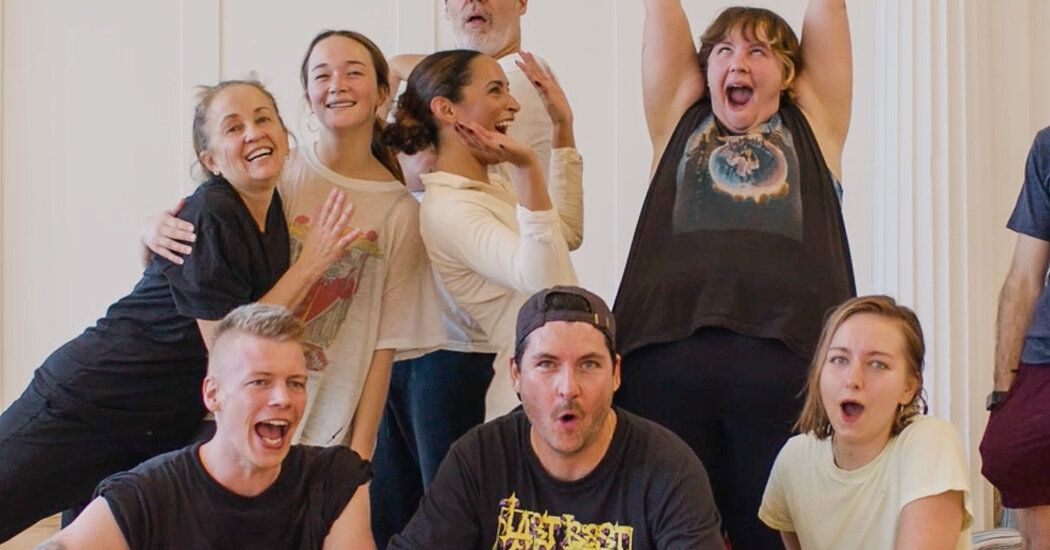Every time Alex Lee mentions Clown Cardio, he is met with some confusion.
“People will say, 'What is that? People dressed like clowns chasing you?'” Lee, a 42-year-old technical writer who lives in Los Angeles, said after a recent class. No one is wearing face paint or red noses, nor are they necessarily chasing anyone (more on that later), but this one-hour session, which costs $20, incorporated a bicycle horn, mini circus tents from Ikea, and boxes of popcorn from carnival style corn.
Jaymie Parkkinen, who founded the class at Pieter Performance Space in Los Angeles, compiles theater games usually reserved for improv warm-ups and turns them into aerobic exercises with clown-themed props—a game similar to blob tag, in which those tagged join arms and chase everyone; a more chaotic version of musical chairs; a circus tent version of Capture the Flag; Messy dance contests.
When Mr. Parkkinen wants to expand the class repertoire, he visits the Los Angeles Central Library and examines the performance section; He recently became inspired by exercises found in a book for vaudevillians from the 1920s.
In this class, attendees of all genders and ages are encouraged to let it all out. “I want to emphasize the game, not the winning,” Parkkinen announced before Clown Dodge Ball. The disco tune “Turn the Beat Around” played as half the class competed to turn the boxes of popcorn scattered around the room upright, while the other tried to have more face down when the song ended.
“I can unzip my human suit and be a gross little leprechaun, and that's accepted because clowns are tapping into their inner child,” said Sarah Thompson, 29, a North Hollywood-based marketing copywriter who has taken four classes. .
Los Angeles is already home to a vibrant clown community, with clown workshops and shows like Clown Church, Clown Zoo, a psychedelic clown workshop, The Idiot Workshop, and a clown awards show, but Clown Cardio focuses exclusively on exercise.
Clown Cardio was conceived and launched in September 2023, shortly after Mr. Parkkinen's mother was diagnosed with late-stage cancer. Parkkinen, who had worked part-time as a lawyer at an entertainment company, was inspired to focus more specifically on what brought him joy, and that was improv warm-ups, where silliness and physicality come into full effect.
With play as the goal, laughter and sound are one of the metrics Mr. Parkkinen uses to measure the success of each class: “For me it is the auditory element. It is difficult to visually decipher the level of joy.”
Can nonsense improve a workout? According to Professor Sophie Scott, a laughter neuroscientist at University College London, laughter alone doesn't burn many calories. But, like exercise, laughing causes a significant increase in endorphins. Over time, laughing leads to a reduction in the stress hormone cortisol, she said.
Professor Michelle Liu Carriger, chair of the UCLA theater department, believes the clown's recent popularity could be due to people realizing that seriousness doesn't get us where we need to go. “What got us through difficult pandemic times was not just washing our hands and listening to health professionals, but finding ways to disconnect, relax and let off steam.”
Many class attendees said what they loved about Clown Cardio, which meets in three Los Angeles neighborhoods, is connecting with others. Matthew Moore, actor, producer and artistic director of Improv for the People, 55, stands 6 feet 4 inches tall and is careful not to bump into what he calls “smaller people” during class.
Throughout the hour, the contestants were gentle with each other, making sure no one got hurt during a heated fight. Safety is a crucial part of maintaining classroom humor. “It's not funny if a clown gets hit in the face with a frying pan and then doesn't get up,” said Sam Sullivan, 25, a stage carpenter who lives in El Sereno who took a clown class during college and now attend Clown Cardio. In fact, “that's sad.”
Several students said taking the class helped them deal with coulrophobia, or clown phobia. Max. Sullivan used to be afraid of clowns, but he came to the conclusion that “clowning is not so much about painting your face and scaring people, but about defying failure.”












